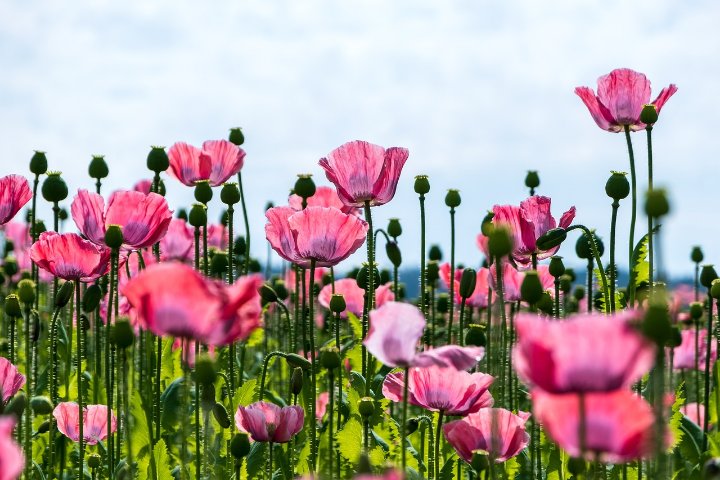Common poppy, also known as Papaver rhoeas, is a delightful addition to any garden, adding a splash of vibrant color and a touch of whimsy to the landscape. With its delicate petals and striking hues, the common poppy is a favorite among gardeners and wildflower enthusiasts alike. Whether you’re looking to cultivate a patch of wildflowers or add visual interest to your flower beds, common poppies are a versatile and low-maintenance option. Let’s delve into how to grow and care for these charming blooms.
Best Poppy Varieties
| Image | Name | Rating | Shop |
|---|---|---|---|
 | Shirley Mixed Poppy Seeds |  | |
 | Iceland Poppy Seeds Flower Mix |  | |
 | Giant Purple Poppy |  |
Common Poppy Hardiness Zones
One of the remarkable features of common poppies is their adaptability to a wide range of climates. They are hardy in USDA zones 1-10, thriving in both temperate and Mediterranean environments. Whether you live in a chilly northern region or a balmy southern area, you can grow common poppies with ease, making them a popular choice for gardeners across diverse geographical regions.
How Much Sun Do Common Poppy Need
Common poppies are sun-loving plants that thrive in full to partial sunlight. Plant them in a location where they can receive at least six hours of direct sunlight per day for optimal growth and flowering. In areas with scorching afternoon sun, partial shade during the hottest part of the day can help protect the delicate blooms and prevent wilting. With proper sun exposure, common poppies will reward you with an abundance of colorful flowers throughout the growing season.
Common Poppy Soil Requirements
When it comes to soil, common poppies prefer well-drained, sandy loam that is rich in organic matter. They can tolerate a wide range of soil types, including clay and rocky soils, as long as the drainage is good. Aim for a soil pH that is neutral to slightly acidic, typically ranging from 6.0 to 7.0, to create optimal growing conditions for your poppies. Avoid waterlogged or compacted soil, as it can lead to root rot and other moisture-related problems.
Common Poppy Plant Spacing
Common poppies can grow up to 28 inches tall, depending on the variety and growing conditions. When planting poppies, space them approximately 8 to 12 inches apart to allow for proper air circulation and prevent overcrowding. This spacing ensures that each plant has enough room to grow and spread, resulting in healthier foliage and more abundant flowering. Follow spacing recommendations provided on the seed packet or plant label for best results.
Common Poppy Water Requirements
One of the benefits of growing common poppies is their minimal water needs. These drought-tolerant plants are well-adapted to dry conditions and prefer soil that is on the drier side. Water newly planted poppies regularly to establish strong root systems, but once established, they typically require little to no supplemental watering. Avoid overwatering, as it can lead to root rot and other moisture-related issues. Allow the soil to dry out between waterings to prevent waterlogged conditions.
Common Poppy Temperature and Humidity Requirements
Common poppies thrive in temperate environments with moderate temperatures and are not overly sensitive to humidity levels. They can tolerate a wide range of temperature fluctuations, making them suitable for growing in diverse climates. While they prefer mild weather conditions, common poppies can withstand brief periods of heat and cold without significant damage. Provide adequate air circulation around the plants to prevent moisture buildup, which can lead to fungal diseases in humid conditions.
Common Poppy Fertilizer Requirements
One of the remarkable attributes of common poppies is their ability to thrive without the need for supplemental fertilization. These self-sufficient plants can obtain essential nutrients from the soil and organic matter, making them a low-maintenance option for gardeners. Avoid over-fertilizing common poppies, as excessive nutrients can lead to lush foliage at the expense of flowers. Instead, focus on providing well-amended soil and occasional top-dressing with compost to promote healthy growth and flowering.
Common Poppy Pests and Diseases
While common poppies are relatively pest and disease-resistant, they may occasionally encounter issues with aphids, which can infest the tender new growth and flower buds. Monitor your poppy plants regularly for signs of aphid infestations and take appropriate measures to control them, such as handpicking or using insecticidal soap. Additionally, common poppies may be susceptible to powdery mildew, especially in humid conditions. Ensure proper air circulation and avoid overhead watering to minimize the risk of disease.













